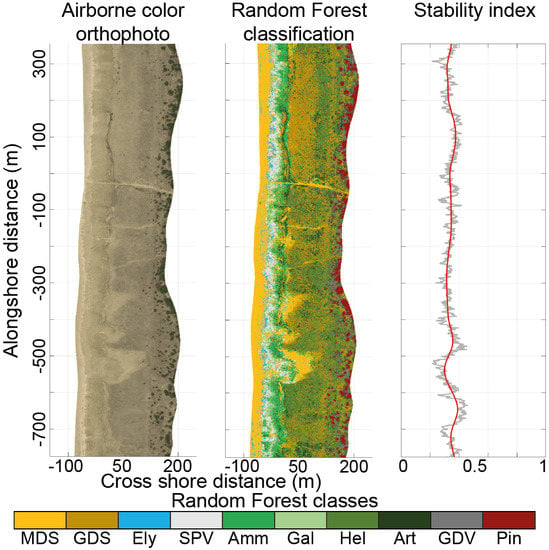Classification of Atlantic Coastal Sand Dune Vegetation Using In Situ, UAV, and Airborne Hyperspectral Data
Abstract
1. Introduction
2. Study Area
3. Materials and Methods
3.1. Airborne Hyperspectral Data
3.2. UAV Data
3.3. Ground Hyperspectral Data
3.4. Pixel-Based Classification
3.4.1. End-Member Spectra
3.4.2. Normalized Difference Vegetation Index Filter
3.4.3. Random Forest
3.5. Stability Index
4. Results
4.1. Analysis of Spectral Signatures of Ground Cover Types
4.2. Assessment of Pixel-Based Supervised Classification Performances
4.3. Spatial Distribution of Coastal Dune Vegetation
5. Discussion
6. Conclusions
Supplementary Materials
Author Contributions
Funding
Acknowledgments
Conflicts of Interest
Appendix A
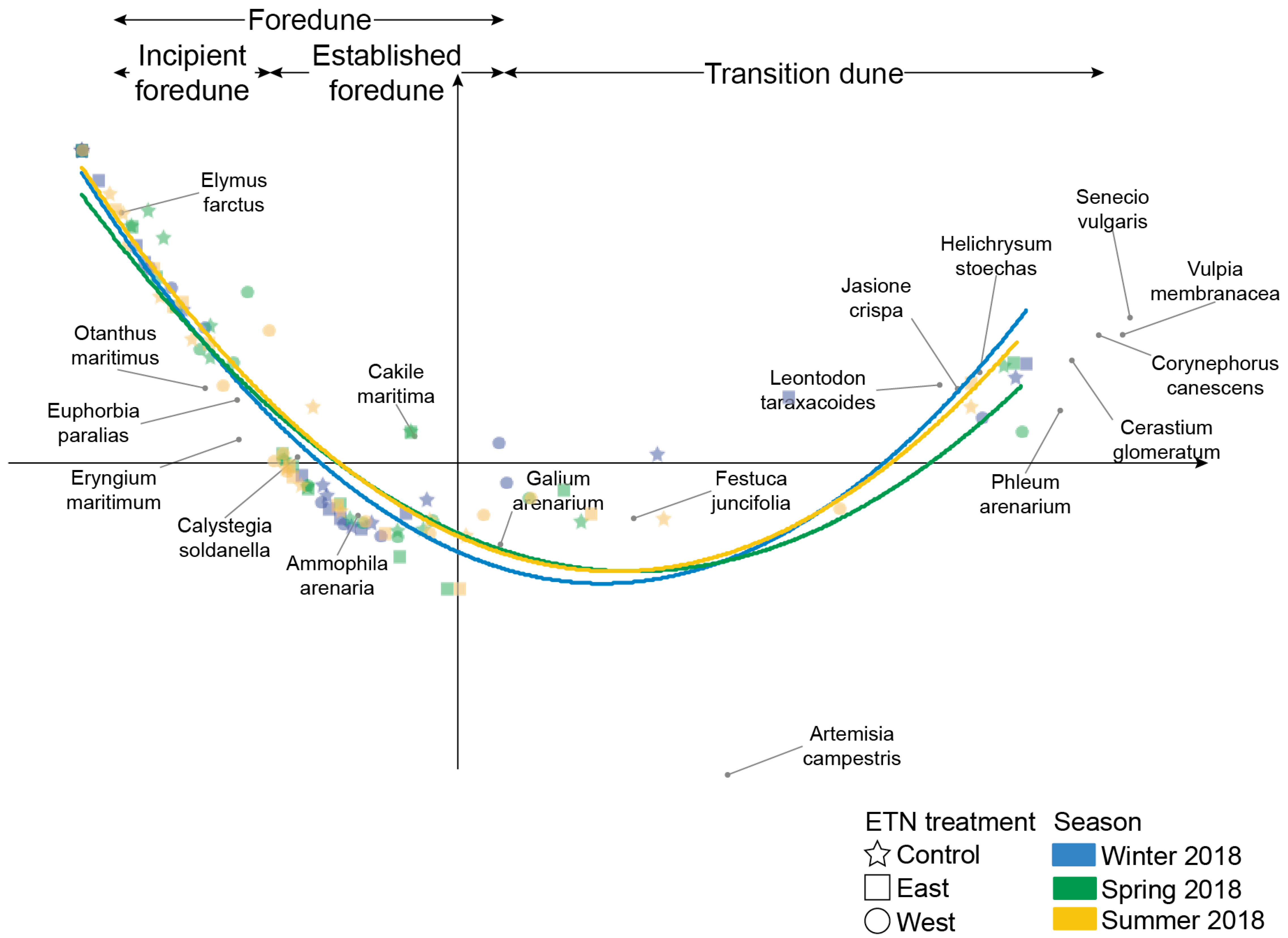
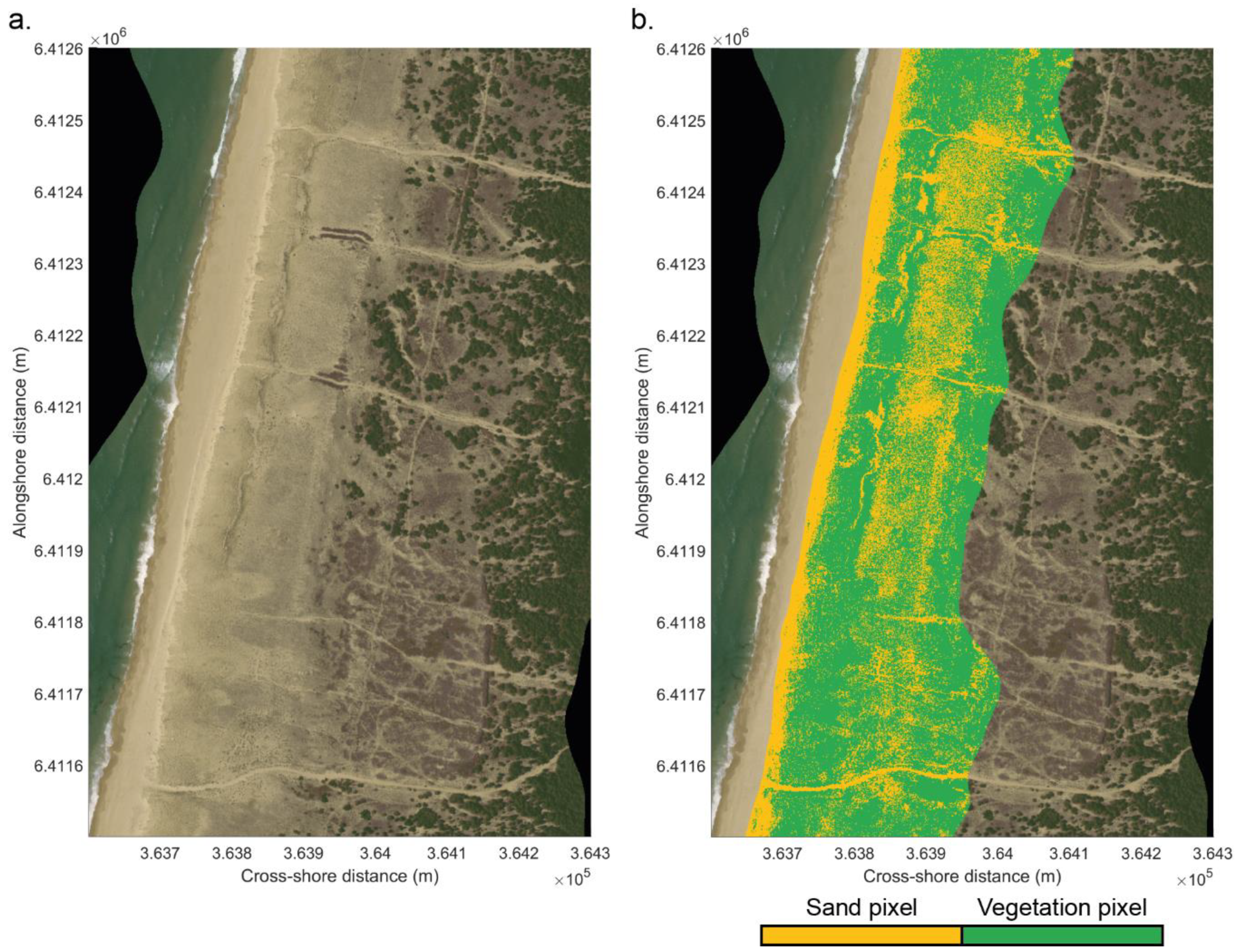
References
- Swift, D.J.P. Coastal sedimentation. In Marine Sediment Transport and Environmental Management; Stanley, D.J., Swift, D.J.P., Eds.; Wiley: New York, NY, USA, 1996; pp. 255–3101. [Google Scholar]
- Short, A.D.; Hesp, P.A. Wave, beach and dune interactions in southeastern Australia. Mar Geol. 1982, 48, 259–284. [Google Scholar] [CrossRef]
- Nordstrom, K.F. Beaches and Dunes of Developed Coasts; Cambridge University Press: Cambrige, UK, 2000. [Google Scholar]
- Hesp, P.A. Foredunes and blowouts: Initiation, geomorphology and dynamics. Geomorphology 2002, 48, 245–268. [Google Scholar] [CrossRef]
- Psuty, N. The coastal foredune: A morphological basis for regional coastal dune development. In Coastal Dunes; Martínez, M.L., Psuty, N.P., Eds.; Springer: Berlin, Germany, 2008; Volume 171, pp. 11–27. [Google Scholar]
- Zarnetske, P.L.; Hacker, S.D.; Seabloom, E.W.; Ruggiero, P.; Killian, J.R.; Maddux, T.B.; Cox, D. Biophysical feedback mediates effects of invasive grasses on coastal dune shape. Ecology 2012, 93, 1439–1450. [Google Scholar] [CrossRef] [PubMed]
- Hesp, P.A.; Walker, I.J. Aeolian environments: Coastal dunes. In Treatrise on Geomorphology, Volume 11: Aeolian Geomorphology; Shroder, J., Lancaster, N., Sherman, D.J., Baas, A.C.W., Eds.; Academic Press: San Diego, CA, USA, 2013; pp. 109–133. [Google Scholar]
- Oosting, H. Tolerance to salt spray of plants of coastal dunes. Ecology 1945, 26, 85–89. [Google Scholar] [CrossRef]
- Barbour, M.; Jong, T.; Pavlik, B. Marine beach and dune plant communities. In Physiological Ecology of North American Plant Communities; Chabot, B., Mooney, H., Eds.; Chapman & Hall and Methuen: New York, NY, USA, 1985; pp. 296–322. [Google Scholar]
- Wilson, J.B.; Sykes, M.T. Is zonation on coastal sand dunes determined primarily by sand burial or by salt spray? A test in New Zealand dunes. Ecol. Lett. 1999, 2, 233–236. [Google Scholar] [CrossRef]
- Houser, C.; Wernette, P.; Rentschlar, E.; Jones, H.; Hammond, B.; Trimble, S. Post-storm beach and dune recovery: Implications for barrier island resilience. Geomorphology 2015, 234, 54–63. [Google Scholar] [CrossRef]
- Martinez, M.L.; Hesp, P.A.; Gallego-Fernandez, J.B. Coastal dunes: Human impact and need for restoration. In Restoration of Coastal Dunes; Martinez, M.L., Gallego-Fernández, J.B., Hesp, P., Eds.; Springer: Berlin/Heidelberg, Germany, 2013; pp. 1–14. [Google Scholar]
- Bakker, M.A.J.; van Heteren, S.; Vonhogen, L.M.; van der Spek, A.J.F.; van der Valk, B. Recent coastal dune development: Effect of sand nourishments. J. Coast. Res. 2012, 23, 587–601. [Google Scholar]
- Arens, S.M.; Baas, A.C.W.; van Boxel, J.H.; Kaleman, C. Influence of reed stem density on foredune development. Earth Surf. Process. Landf. 2001, 26, 1161–1176. [Google Scholar] [CrossRef]
- Ruz, M.H.; Anthony, E.J. Trapping by brushwood fences on a beach-foredune contact: The primacy of the local sediment budget. Zeitschrift fur Geomorphol. 2008, 52, 179–194. [Google Scholar] [CrossRef]
- Nordstrom, K.F.; Arens, S.M. The role of human actions in evolution and management of foredunes in the Netherlands and New Jersey, USA. J. Conserv. 1998, 4, 169–180. [Google Scholar] [CrossRef]
- Nordstrom, K.F.; Lampe, R.; Vandemark, L.M. Re-shaping naturally-functioning dunes on developed coasts. Environ. Manag. 2000, 25, 37–51. [Google Scholar] [CrossRef] [PubMed]
- Jackson, N.L.; Nordstrom, K.F. Aeolian sediment transport and morphologic change on a managed and an unmanaged foredune. Earth Surf. Process. Landf. 2013, 38, 413–420. [Google Scholar] [CrossRef]
- Castelle, B.; Laporte-Fauret, Q.; Marieu, V.; Michalet, R.; Rosebery, D.; Bujan, S.; Lubac, B.; Bernard, J.-B.; Valance, A.; Dupont, P.; et al. Nature-Based Solution along High-Energy Eroding Sandy Coasts: Preliminary Tests on the Reinstatement of Natural Dynamics in Reprofiled Coastal Dunes. Water 2019, 11, 2518. [Google Scholar] [CrossRef]
- Durán, O.; Moore, L.J. Vegetation controls on the maximum size of coastal dunes. Proc. Natl. Acad. Sci. USA 2013, 110, 17217–17222. [Google Scholar] [CrossRef] [PubMed]
- Seabloom, E.W.; Ruggiero, P.; Hacker, S.D.; Mull, J.; Zarnetske, P. Invasive grasses, climate change, and exposure to storm-wave overtopping in coastal dune ecosystems. Glob. Chang. Biol 2013, 19, 824–832. [Google Scholar] [CrossRef]
- Psuty, N.P.; Silveira, T.M. Global climate change: An opportunity for coastal dunes? J. Coast. Conserv. 2010, 14, 153–160. [Google Scholar] [CrossRef]
- Adam, E.; Mutanga, O.; Rugege, D. Multispectral and hyperspectral remote sensing for identification and mapping of wetland vegetation: A review. Wetlands Ecol. Manag. 2010, 18, 281–296. [Google Scholar] [CrossRef]
- Marzialetti, F.; Giulio, S.; Malavasi, M.; Sperandii, M.G.; Rosario Acosta, A.T.; Carranza, M.L. Capturing coastal dune natural vegetation types using a phenology-based mapping approach: The potential of Sentinel-2. Remote Sens. 2019, 11, 1506. [Google Scholar] [CrossRef]
- De Giglio, M.; Greggio, N.; Goffo, F.; Merloni, N.; Dubbini, M.; Barbarella, M. Comparison of pixel- and object-based classification methods of unmanned aerial vehicle data applied to coastal dune vegetation communities: Casal borsetti case study. Remote Sens. 2019, 11, 1416. [Google Scholar] [CrossRef]
- Lawley, V.; Lewis, M.; Clarke, K.; Ostendorf, B. Site-based and remote sensing methods for monitoring indicators of vegetation condition: An Australian review. Ecol. Indic. 2016, 60, 1273–1283. [Google Scholar] [CrossRef]
- Valentini, E.; Taramelli, A.; Cappucci, S.; Filipponi, F.; Nguyen Xuan, A. Exploring the Dunes: The Correlations between Vegetation Cover Pattern and Morphology for Sediment Retention Assessment Using Airborne Multisensor Acquisition. Remote Sens. 2020, 12, 1229. [Google Scholar] [CrossRef]
- Rapinel, S.; Clément, B.; Magnanon, S.; Sellin, V.; Hubert-Moy, L. Identification and mapping of natural vegetation on a coastal site using a Worldview-2 satellite image. J. Environ. Manag. 2014, 144, 236–246. [Google Scholar] [CrossRef] [PubMed]
- Medina Machín, A.; Marcello, J.; Hernández-Cordero, A.I.; Martín Abasolo, J.; Eugenio, F. Vegetation species mapping in a coastal-dune ecosystem using high resolution satellite imagery. GISci. Remote Sens. 2019, 56, 210–232. [Google Scholar] [CrossRef]
- Hennessy, A.; Clarke, K.; Lewis, M. Hyperspectral Classification of Plants: A Review of Waveband Selection Generalisability. Remote Sens. 2020, 12, 113. [Google Scholar] [CrossRef]
- Filippi, A.M.; Jensen, J.R. Fuzzy learning vector quantization for hyperspectral coastal vegetation classification. Remote Sens. Environ. 2006, 100, 512–530. [Google Scholar] [CrossRef]
- Timm, B.C.; McGarigal, K. Fine-scale remotely-sensed cover mapping of coastal dune and salt marsh ecosystems at Cape Cod National Seashore using Random Forests. Remote Sens. Environ. 2012, 127, 106–117. [Google Scholar] [CrossRef]
- Schmidt, K.S.; Skidmore, A.K. Spectral discrimination of vegetation types in a coastal wetland. Remote Sens. Environ. 2003, 85, 92–108. [Google Scholar] [CrossRef]
- Marcos Jiménez, M.; Díaz-Delgado, R. Towards a standard plant species spectral library protocol for vegetation mapping: A case study in the shrubland of Doñana National Park. ISPRS Int. J. Geoinf. 2015, 4, 2472–2495. [Google Scholar] [CrossRef]
- Castelle, B.; Bujan, S.; Ferreira, S.; Dodet, G. Foredune morphological changes and beach recovery from the extreme 2013/2014 winter at a high-energy sandy coast. Mar. Geol. 2017, 385, 41–55. [Google Scholar] [CrossRef]
- Laporte-Fauret, Q.; Marieu, V.; Castelle, B.; Michalet, R.; Bujan, S.; Rosebery, D. Low-Cost UAV for high-resolution and large-scale coastal dune change monitoring using photogrammetry. J. Mar. Sci. Eng. 2019, 7, 63. [Google Scholar] [CrossRef]
- Forey, E.; Chapelet, B.; Tilquin, M.; Vitasse, Y.; Touzard, B.; Michalet, R. The relative importance of disturbance and environmental stress at local and regional scales in French coastal sand dunes. J. Veg. Sci. 2008, 19, 493–502. [Google Scholar] [CrossRef]
- Forey, E.; Touzard, B.; Michalet, R. Does disturbance drive the collapse of biotic interactions at the severe end of a diversity-biomass gradient? Plant Ecol. 2010, 206, 287–295. [Google Scholar] [CrossRef]
- Le Bagousse-Pinguet, Y.; Forey, E.; Touzard, B.; Michalet, R. Disentangling the effects of water and nutrients for studying the outcome of plant interactions in sand dune ecosystems. J. Veg. Sci. 2013, 24, 375–383. [Google Scholar] [CrossRef]
- Laporte-Fauret, Q.; Alonso Ayuso, A.T.; Rodolfo-Damiano, T.; Marieu, V.; Castelle, B.; Bujan, S.; Rosebery, D.; Michalet, R. The role of physical disturbance for ecosystem functioning in coastal sand dunes. Sci. Total Environ. submitted.
- Castelle, B.; Marieu, V.; Bujan, S.; Splinter, K.D.; Robinet, A.; Sénéchal, N.; Ferreira, S. Impact of the winter 2013–2014 series of severe Western Europe storms on a double-barred sandy coast: Beach and dune erosion and megacusp embayments. Geomorphology 2015, 238, 135–148. [Google Scholar] [CrossRef]
- Castelle, B.; Dodet, G.; Masselink, G.; Scott, T. A new climate index controlling winter wave activity along the Atlantic coast of Europe: The West Europe Pressure Anomaly. Geophys. Res. Lett. 2017, 44, 1384–1392. [Google Scholar] [CrossRef]
- Castelle, B.; Guillot, B.; Marieu, V.; Chaumillon, E.; Hanquiez, V.; Bujan, S.; Poppeschi, C. Spatial and temporal patterns of shoreline change of a 280-km long high-energy disrupted sandy coast from 1950 to 2014: SW France. Estuar. Coast. Shelf Sci. 2018, 200, 212–223. [Google Scholar] [CrossRef]
- Laporte-Fauret, Q.; Castelle, B.; Marieu, V.; Bujan, S.; Michalet, R.; Rosebery, D. Coastal dune morphology evolution combining Lidar and UAV surveys, Truc Vert beach 2011–2019. In Global Coastal Issues of 2020. Journal of Coastal Research; Special Issue No. 95; Malvárez, G., Navas, F., Eds.; Coastal Education and Research Foundation, Inc.: Coconut Creek, FL, USA, 2020; pp. 163–167. [Google Scholar]
- Robin, N.; Billy, J.; Castelle, B.; Hesp, P.; Nicolae Lerma, A.; Laporte-Fauret, Q.; Marieu, V.; Rosebery, D.; Bujan, S.; Destribats, B.; et al. 150 years of Foredune initiation and evolution driven by human and natural processes. Geomorphology, submitted.
- Barrère, P. Dynamics and management of the coastal dunes of the Landes, Gascony, France. Coastal Dunes: Geomorphology, ecology and management for conservation. In Proceedings of the 3rd European Dune Congress, Galway, Ireland, 17–21 June 1992; Carter, R.W.G., Curtis, T.G.F., Sheehy-Skeffington, M.J., Eds.; pp. 25–32. [Google Scholar]
- Prat, M.; Auly, T. L’évolution du littoral médocain à Lacanau. Sud-Ouest Eur. 2010, 29, 53–64. [Google Scholar] [CrossRef]
- Richter, R.D. Atmospheric/Topographic Correction for Airborne Imagery. In DLR Report; DLR-IB 565-02/14, 240; DLR: Cologne, Germany, 2014. [Google Scholar]
- Combe, J.P.; Launeau, P.; Pinet, P.; Despan, D.; Harris, E.; Ceuleneer, G.; Sotin, C. Mapping of an ophiolite complex by high-resolution visible-infrared spectrometry. Geochem. Geophys. Geosyst. 2006, 7. [Google Scholar] [CrossRef]
- Friedl, M.A.; Davis, F.W.; Michaelsen, J.; Moritz, M.A. Scaling and uncertainty in the relationship between the NDVI and land surface biophysical variables: An analysis using a scene simulation model and data from FIFE. Remote Sens. Environ. 1995, 54, 233–246. [Google Scholar] [CrossRef]
- Chen, J.M. Spatial scaling of a remotely sensed surface parameter by contexture. Remote Sens. Environ. 1999, 69, 30–42. [Google Scholar] [CrossRef]
- Launeau, P.; Kassouk, Z.; Debaine, F.; Roy, R.; Mestayer, P.G.; Boulet, C.; Rouaud, J.-M.; Giraud, M. Airborne hyperspectral mapping of trees in an urban area. Int. J. Remote Sens. 2017, 38, 1277–1311. [Google Scholar] [CrossRef]
- Hommersom, A.; Kratzer, S.; Laanen, M.; Ansko, I.; Ligi, M.; Bresciani, M.; Giardino, C.; Beltrán-Abaunza, J.M.; Moore, G.; Wernand, M.; et al. Intercomparison in the field between the new WISP-3 and other radiometers (TriOS Ramses, ASD FieldSpec, and TACCS). J. Appl. Remote Sens. 2012, 6, 063615. [Google Scholar] [CrossRef]
- Proença, B.; Frappart, F.; Lubac, B.; Marieu, V.; Ygorra, B.; Bombrun, L.; Michalet, R.; Sottolichio, A. Potential of High-Resolution Pléiades Imagery to Monitor Salt Marsh Evolution After Spartina Invasion. Remote Sens. 2019, 11, 968. [Google Scholar] [CrossRef]
- Tucker, C.J. Red and photographic infrared linear combinations for monitoring vegetation. Remote Sens. Environ. 1979, 8, 127–150. [Google Scholar] [CrossRef]
- Pettorelli, N.; Vik, J.O.; Mysterud, A.; Gaillard, J.-M.; Tucker, C.J.; Stenseth, N.C. Using the satellite-derived NDVI to assess ecological responses to environmental change. Trends Ecol. Evol. 2005, 20, 503–510. [Google Scholar] [CrossRef] [PubMed]
- Verbesselt, J.; Hyndman, R.; Newnham, G.; Culvenor, D. Detecting trend and seasonal changes in satellite image time series. Remote Sens. Environ. 2010, 114, 106–115. [Google Scholar] [CrossRef]
- Breiman, L. Random Forests. Mach. Learn. 2001, 45, 5–32. [Google Scholar] [CrossRef]
- Juel, A.; Groom, G.B.; Svenning, J.C.; Ejrnæs, R. Spatial application of Random Forest models for fine-scale coastal vegetation classification using object based analysis of aerial orthophoto and DEM data. Int. J. Appl. Earth Observ. Geoinf. 2015, 42, 106–114. [Google Scholar] [CrossRef]
- Correll, M.D.; Hantson, W.; Hodgman, T.P.; Cline, B.B.; Elphick, C.S.; Gregory Shriver, W.; Tymkiw, E.L.; Olsen, B.J. Fine-scale mapping of coastal plant communities in the northeastern USA. Wetlands 2019, 39, 17–28. [Google Scholar] [CrossRef]
- Silvestri, S.; Marani, M.; Settle, J.; Benvenuto, F.; Marani, A. Salt marsh vegetation radiometry: Data analysis and scaling. Remote Sens. Environ. 2002, 80, 473–482. [Google Scholar] [CrossRef]
- Foody, G.M. Status of land cover classification accuracy assessment. Remote Sens. Environ. 2002, 80, 185–201. [Google Scholar] [CrossRef]
- Fisk, C.; Clarke, K.D.; Lewis, M.M. Comparison of hyperspectral versus traditional field measurements of fractional ground cover in the Australian arid zone. Remote Sens. 2019, 11, 2825. [Google Scholar] [CrossRef]

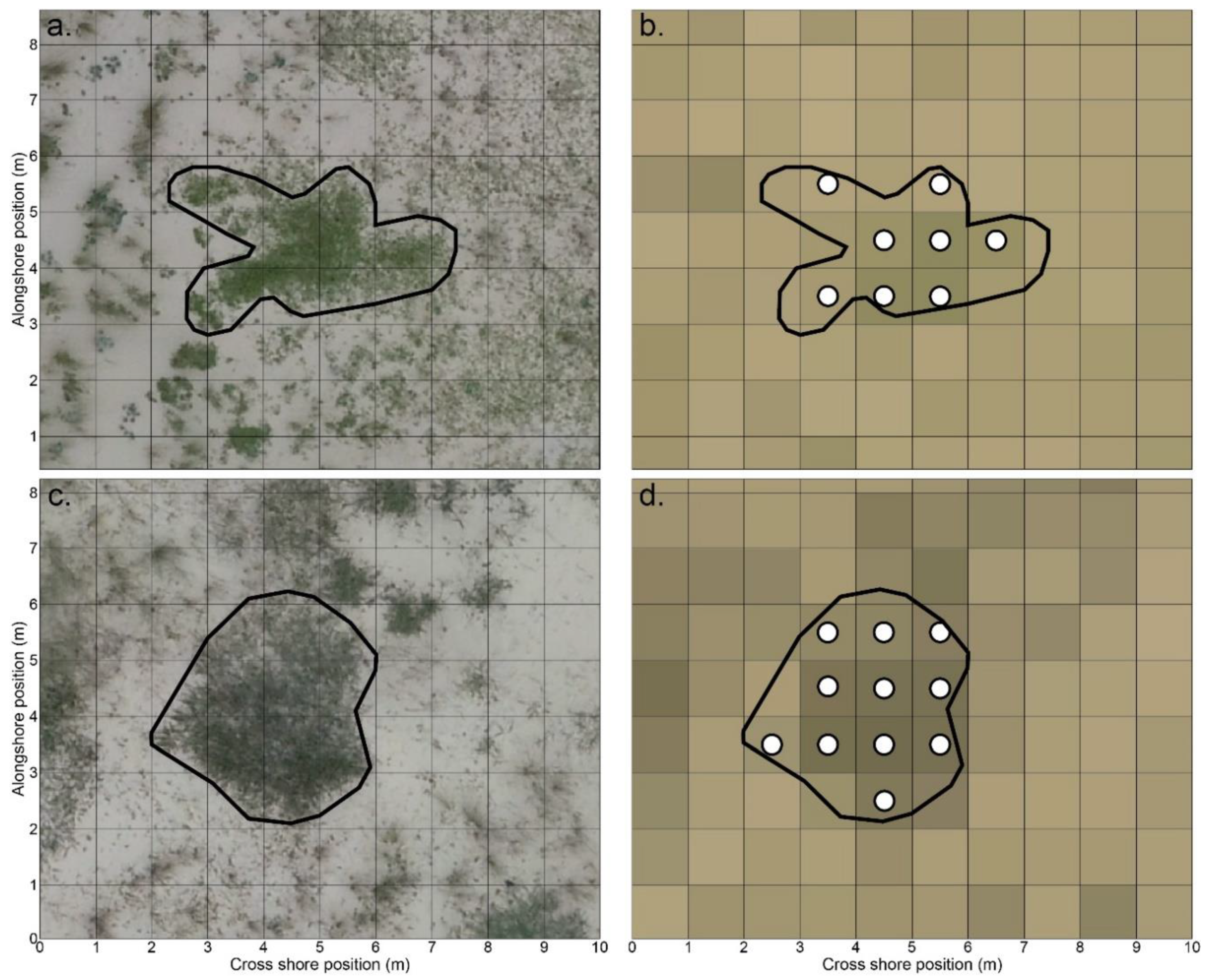
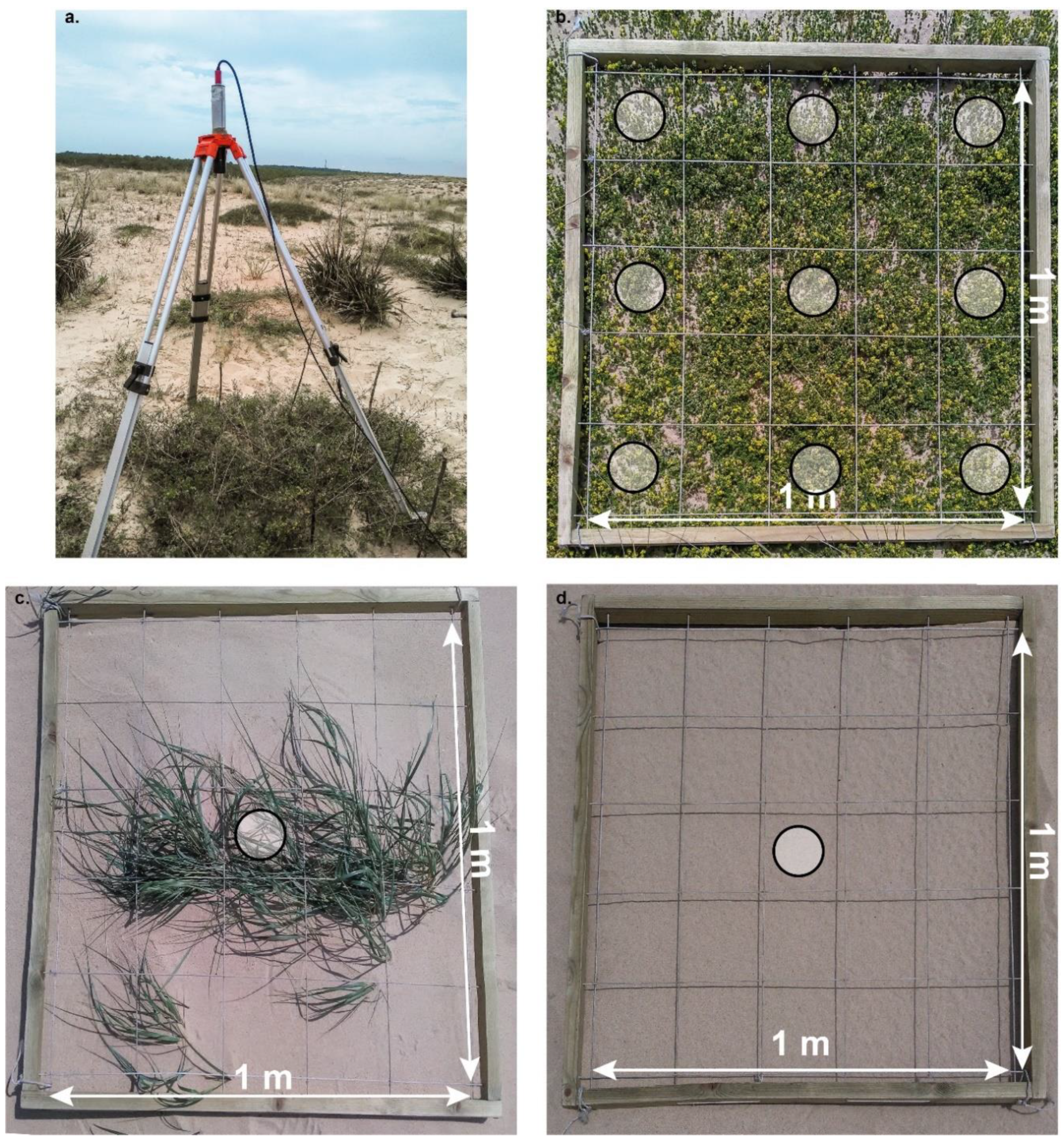


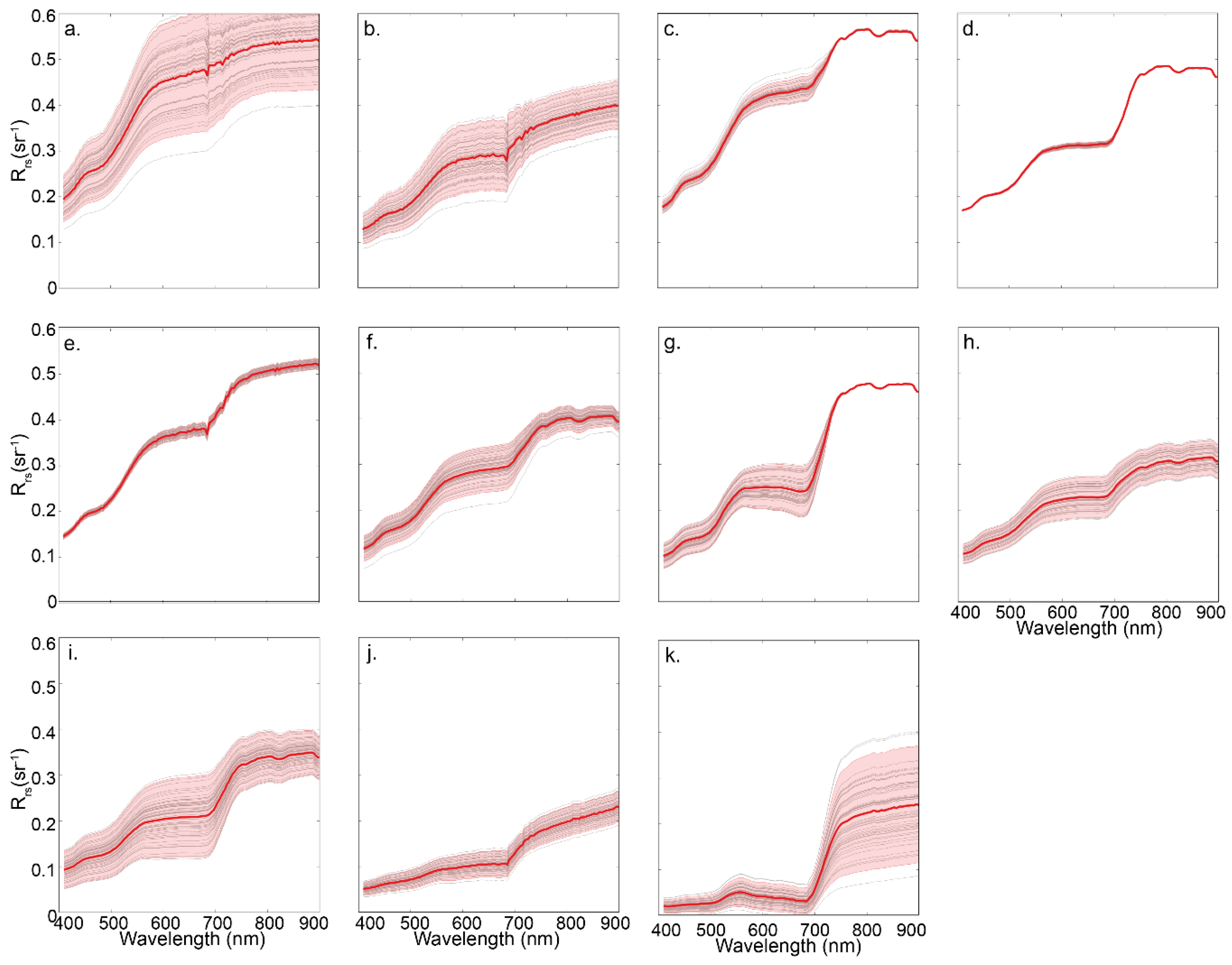


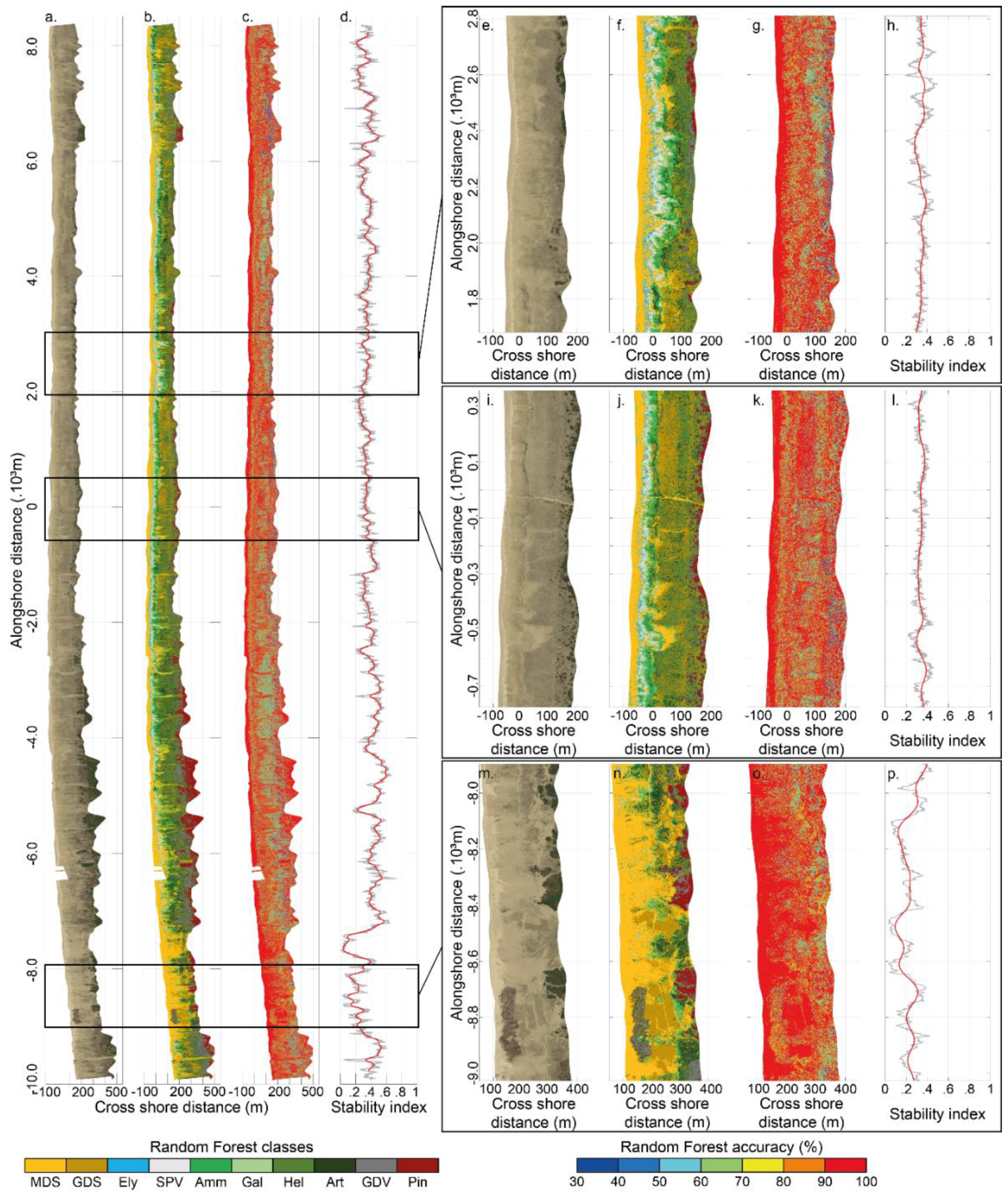
| Classes | Characteristics of Ground Covers | Sampling Strategy | # Collected Replicates |
|---|---|---|---|
| Amm | Large patches | Field 9 points/quadra | 90 |
| Gal | Large patches | Field 9 points/quadra | 90 |
| Hel | Large patches | Field 9 points/quadra | 90 |
| Art | Large patches | Field 9 points/quadra | 90 |
| Ely | Small patches | Field 1 point/quadra | 30 |
| Ota | Small patches | Field 1 point/quadra | 30 |
| MDS | Spatially homogeneous | Field 1 point/quadra | 30 (IFS) 30 (EFS) |
| GDS | Spatially homogeneous | Field 1 point/quadra | 30 |
| SPV | Very Small patches High intra-pixel diversity | Airborne Mask extraction | 176 |
| GDV | Very Small patches High intra-pixel diversity | Airborne Mask extraction | 203 |
| Pin | Height >1 m | Airborne Mask extraction | 159 |
| Class | Axis 1 Value [40] | Stability Index |
|---|---|---|
| MDS | - | 0 |
| GDS | - | 0 |
| Ely | −1.12 | 0.20 |
| Ota | −0.83 | 0.25 |
| SPV | −0.76 | 0.27 |
| Amm | −0.33 | 0.35 |
| Gal | 0.14 | 0.43 |
| Art | 0.90 | 0.57 |
| Hel | 1.75 | 0.73 |
| GDV | 2.14 | 0.8 |
| Pin | - | 1.0 |
| MDS | GDS | Class Accuracy (%) | |
|---|---|---|---|
| MDS | 50 | 0 | 100 |
| GDS | 0 | 50 | 100 |
| Ely | Ota | SPV | Amm | Gal | Hel | Arm | GDV | Pin | Class Accuracy (%) | |
|---|---|---|---|---|---|---|---|---|---|---|
| Ely | 31 | 0 | 19 | 0 | 0 | 0 | 0 | 0 | 0 | 62 |
| Ota | 7 | 5 | 16 | 9 | 9 | 0 | 4 | 0 | 0 | 10 |
| SPV | 0 | 0 | 50 | 0 | 0 | 0 | 0 | 0 | 0 | 100 |
| Amm | 0 | 0 | 0 | 50 | 0 | 0 | 0 | 0 | 0 | 100 |
| Gal | 0 | 0 | 7 | 0 | 43 | 0 | 0 | 0 | 0 | 86 |
| Hel | 0 | 0 | 0 | 0 | 0 | 50 | 0 | 0 | 0 | 100 |
| Arm | 0 | 0 | 0 | 2 | 0 | 0 | 48 | 0 | 0 | 96 |
| GDV | 0 | 0 | 0 | 0 | 0 | 0 | 0 | 50 | 0 | 100 |
| Pin | 0 | 0 | 0 | 2 | 0 | 0 | 3 | 0 | 45 | 90 |
| Ely | Spv | Amm | Gal | Hel | Arm | GDV | Pin | Class Accuracy (%) | |
|---|---|---|---|---|---|---|---|---|---|
| Ely | 32 | 18 | 0 | 0 | 0 | 0 | 0 | 0 | 64 |
| Spv | 0 | 50 | 0 | 0 | 0 | 0 | 0 | 0 | 100 |
| Amm | 0 | 0 | 50 | 0 | 0 | 0 | 0 | 0 | 100 |
| Gal | 0 | 9 | 0 | 41 | 0 | 0 | 0 | 0 | 82 |
| Hel | 0 | 0 | 2 | 0 | 48 | 0 | 0 | 0 | 96 |
| Arm | 0 | 0 | 0 | 0 | 2 | 48 | 0 | 0 | 96 |
| GDV | 0 | 0 | 0 | 0 | 0 | 0 | 50 | 0 | 100 |
| Pin | 0 | 0 | 0 | 0 | 0 | 0 | 0 | 50 | 100 |
| Class | Overall (%) (Figure 9b) | Southern Area (%) (Figure 9n) | Central Area (%) (Figure 9j) | Northern Area (%) (Figure 9f) |
|---|---|---|---|---|
| MDS | 21.84 | 41.20 | 19.12 | 24.83 |
| GDS | 16.16 | 21.63 | 22.87 | 11.27 |
| Ely | 2.42 | 0.34 | 2.62 | 4.86 |
| SPV | 2.61 | 0.22 | 2.99 | 5.92 |
| Amm | 10.64 | 8.11 | 9.95 | 12.22 |
| Gal | 3.63 | 1.82 | 4.14 | 5.69 |
| Hel | 17.77 | 3.80 | 22.66 | 18.54 |
| Arm | 11.44 | 9.85 | 7.74 | 9.51 |
| GDV | 7.40 | 6.05 | 3.84 | 4.53 |
| Pin | 6.09 | 6.98 | 4.07 | 2.63 |
© 2020 by the authors. Licensee MDPI, Basel, Switzerland. This article is an open access article distributed under the terms and conditions of the Creative Commons Attribution (CC BY) license (http://creativecommons.org/licenses/by/4.0/).
Share and Cite
Laporte-Fauret, Q.; Lubac, B.; Castelle, B.; Michalet, R.; Marieu, V.; Bombrun, L.; Launeau, P.; Giraud, M.; Normandin, C.; Rosebery, D. Classification of Atlantic Coastal Sand Dune Vegetation Using In Situ, UAV, and Airborne Hyperspectral Data. Remote Sens. 2020, 12, 2222. https://doi.org/10.3390/rs12142222
Laporte-Fauret Q, Lubac B, Castelle B, Michalet R, Marieu V, Bombrun L, Launeau P, Giraud M, Normandin C, Rosebery D. Classification of Atlantic Coastal Sand Dune Vegetation Using In Situ, UAV, and Airborne Hyperspectral Data. Remote Sensing. 2020; 12(14):2222. https://doi.org/10.3390/rs12142222
Chicago/Turabian StyleLaporte-Fauret, Quentin, Bertrand Lubac, Bruno Castelle, Richard Michalet, Vincent Marieu, Lionel Bombrun, Patrick Launeau, Manuel Giraud, Cassandra Normandin, and David Rosebery. 2020. "Classification of Atlantic Coastal Sand Dune Vegetation Using In Situ, UAV, and Airborne Hyperspectral Data" Remote Sensing 12, no. 14: 2222. https://doi.org/10.3390/rs12142222
APA StyleLaporte-Fauret, Q., Lubac, B., Castelle, B., Michalet, R., Marieu, V., Bombrun, L., Launeau, P., Giraud, M., Normandin, C., & Rosebery, D. (2020). Classification of Atlantic Coastal Sand Dune Vegetation Using In Situ, UAV, and Airborne Hyperspectral Data. Remote Sensing, 12(14), 2222. https://doi.org/10.3390/rs12142222







